Yuxin Xie
ATRI: Mitigating Multilingual Audio Text Retrieval Inconsistencies by Reducing Data Distribution Errors
Feb 22, 2025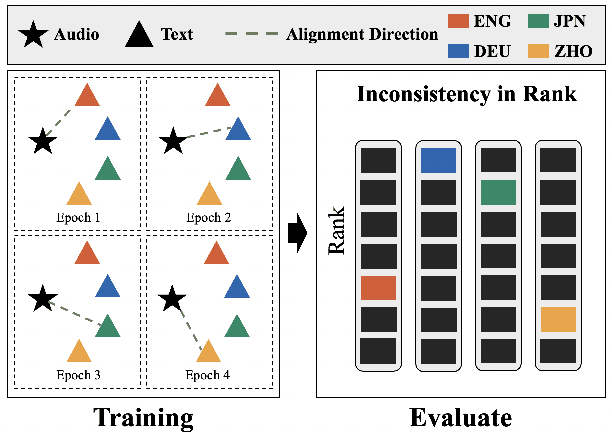
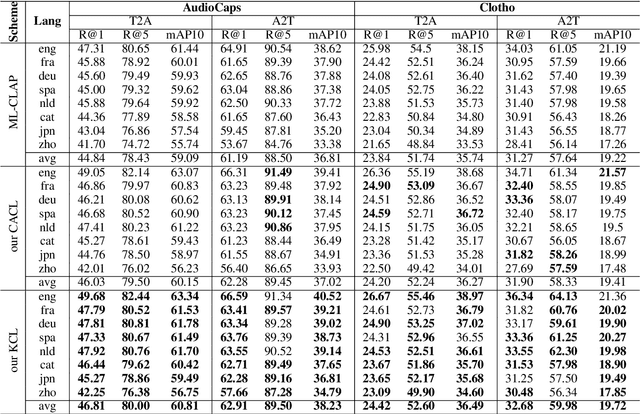
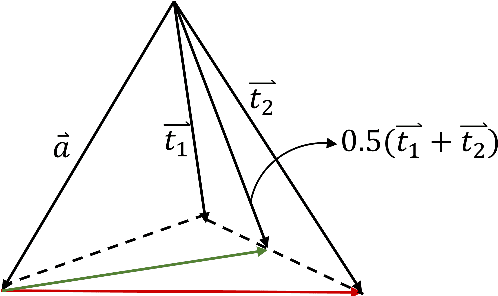
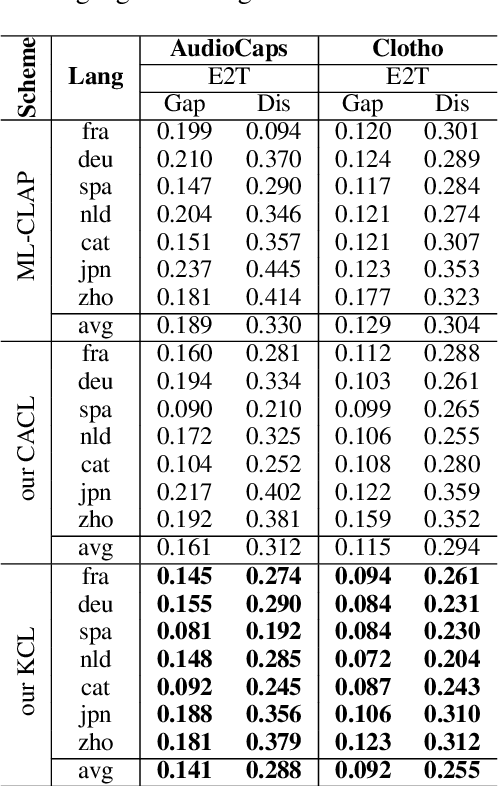
Abstract:Multilingual audio-text retrieval (ML-ATR) is a challenging task that aims to retrieve audio clips or multilingual texts from databases. However, existing ML-ATR schemes suffer from inconsistencies for instance similarity matching across languages. We theoretically analyze the inconsistency in terms of both multilingual modal alignment direction error and weight error, and propose the theoretical weight error upper bound for quantifying the inconsistency. Based on the analysis of the weight error upper bound, we find that the inconsistency problem stems from the data distribution error caused by random sampling of languages. We propose a consistent ML-ATR scheme using 1-to-k contrastive learning and audio-English co-anchor contrastive learning, aiming to mitigate the negative impact of data distribution error on recall and consistency in ML-ATR. Experimental results on the translated AudioCaps and Clotho datasets show that our scheme achieves state-of-the-art performance on recall and consistency metrics for eight mainstream languages, including English. Our code will be available at https://github.com/ATRI-ACL/ATRI-ACL.
Do we really have to filter out random noise in pre-training data for language models?
Feb 10, 2025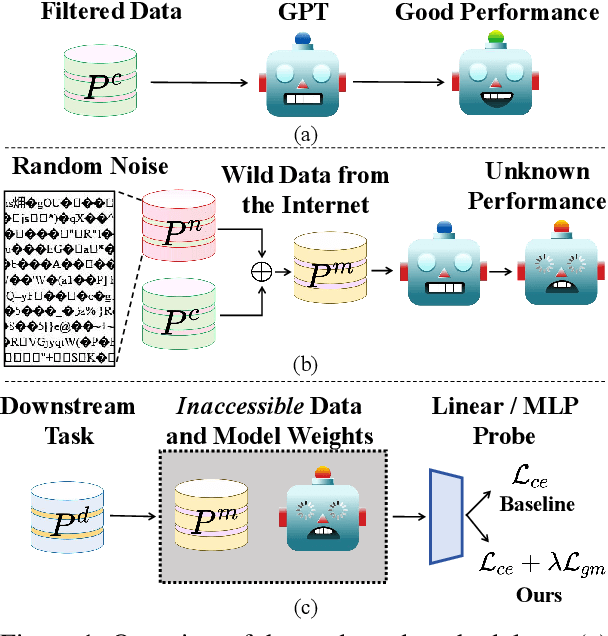



Abstract:Web-scale pre-training datasets are the cornerstone of LLMs' success. However, text data curated from the internet inevitably contains random noise caused by decoding errors or unregulated web content. In contrast to previous works that focus on low quality or synthetic data, our study \textbf{provides the first systematic investigation into such random noise through a cohesive ``What-Why-How'' framework.} Surprisingly, we observed that the resulting increase in next-token prediction (NTP) loss was significantly lower than the proportion of random noise. We provide a theoretical justification for this phenomenon, which also elucidates the success of multilingual models. On the other hand, experiments show that the model's performance in downstream tasks is not based solely on the NTP loss, which means that random noise may result in degraded downstream performance. To address the potential adverse effects, we introduce a novel plug-and-play Local Gradient Matching loss, which explicitly enhances the denoising capability of the downstream task head by aligning the gradient of normal and perturbed features without requiring knowledge of the model's parameters. Additional experiments on 8 language and 14 vision benchmarks further validate its effectiveness.
VARGPT: Unified Understanding and Generation in a Visual Autoregressive Multimodal Large Language Model
Jan 21, 2025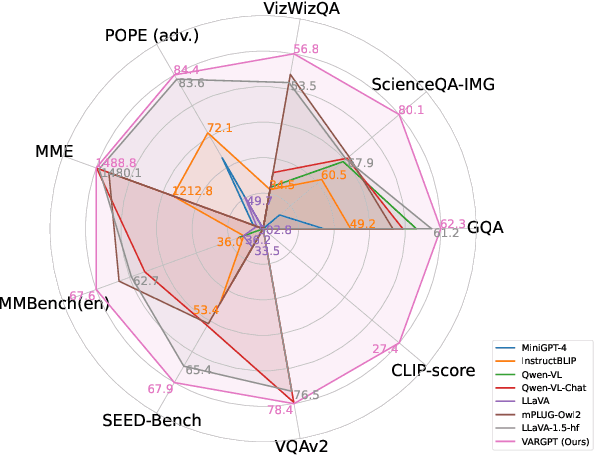
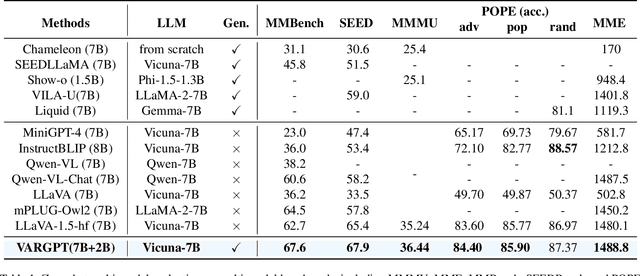
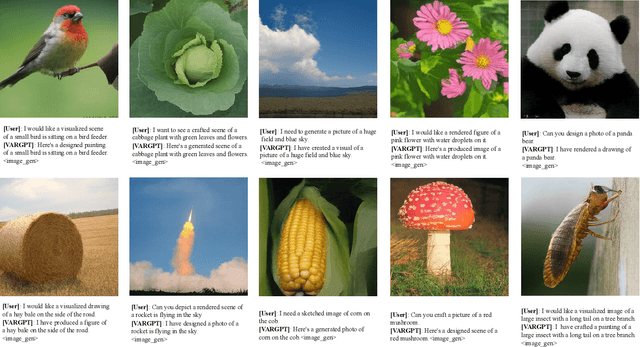
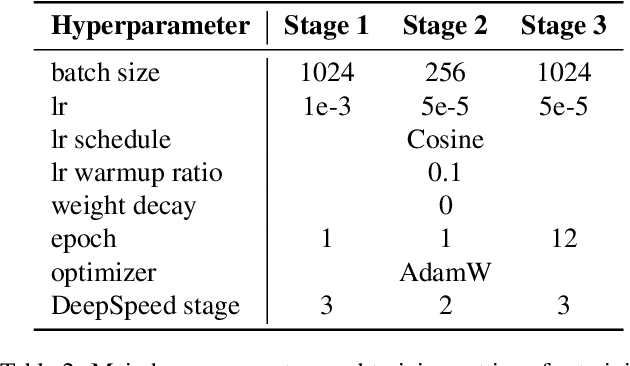
Abstract:We present VARGPT, a novel multimodal large language model (MLLM) that unifies visual understanding and generation within a single autoregressive framework. VARGPT employs a next-token prediction paradigm for visual understanding and a next-scale prediction paradigm for visual autoregressive generation. VARGPT innovatively extends the LLaVA architecture, achieving efficient scale-wise autoregressive visual generation within MLLMs while seamlessly accommodating mixed-modal input and output within a single model framework. Our VARGPT undergoes a three-stage unified training process on specially curated datasets, comprising a pre-training phase and two mixed visual instruction-tuning phases. The unified training strategy are designed to achieve alignment between visual and textual features, enhance instruction following for both understanding and generation, and improve visual generation quality, respectively. Despite its LLAVA-based architecture for multimodel understanding, VARGPT significantly outperforms LLaVA-1.5 across various vision-centric benchmarks, such as visual question-answering and reasoning tasks. Notably, VARGPT naturally supports capabilities in autoregressive visual generation and instruction-to-image synthesis, showcasing its versatility in both visual understanding and generation tasks. Project page is at: \url{https://vargpt-1.github.io/}
VASparse: Towards Efficient Visual Hallucination Mitigation for Large Vision-Language Model via Visual-Aware Sparsification
Jan 11, 2025Abstract:Large Vision-Language Models (LVLMs) may produce outputs that are unfaithful to reality, also known as visual hallucinations (VH), which significantly impedes their real-world usage. To alleviate VH, various decoding strategies have been proposed to enhance visual information. However, many of these methods may require secondary decoding and rollback, which significantly reduces inference speed. In this work, we propose an efficient plug-and-play decoding algorithm via Visual-Aware Sparsification (VASparse) from the perspective of token sparsity for mitigating VH. VASparse is inspired by empirical observations: (1) the sparse activation of attention in LVLMs, and (2) visual-agnostic tokens sparsification exacerbates VH. Based on these insights, we propose a novel token sparsification strategy that balances efficiency and trustworthiness. Specifically, VASparse implements a visual-aware token selection strategy during decoding to reduce redundant tokens while preserving visual context effectively. Additionally, we innovatively introduce a sparse-based visual contrastive decoding method to recalibrate the distribution of hallucinated outputs without the time overhead associated with secondary decoding. Subsequently, VASparse recalibrates attention scores to penalize attention sinking of LVLMs towards text tokens. Extensive experiments across four popular benchmarks confirm the effectiveness of VASparse in mitigating VH across different LVLM families without requiring additional training or post-processing. Impressively, VASparse achieves state-of-the-art performance for mitigating VH while maintaining competitive decoding speed. Code is available at https://github.com/mengchuang123/VASparse-github.
SimTxtSeg: Weakly-Supervised Medical Image Segmentation with Simple Text Cues
Jun 27, 2024



Abstract:Weakly-supervised medical image segmentation is a challenging task that aims to reduce the annotation cost while keep the segmentation performance. In this paper, we present a novel framework, SimTxtSeg, that leverages simple text cues to generate high-quality pseudo-labels and study the cross-modal fusion in training segmentation models, simultaneously. Our contribution consists of two key components: an effective Textual-to-Visual Cue Converter that produces visual prompts from text prompts on medical images, and a text-guided segmentation model with Text-Vision Hybrid Attention that fuses text and image features. We evaluate our framework on two medical image segmentation tasks: colonic polyp segmentation and MRI brain tumor segmentation, and achieve consistent state-of-the-art performance.
Joint End-to-End Image Compression and Denoising: Leveraging Contrastive Learning and Multi-Scale Self-ONNs
Feb 08, 2024



Abstract:Noisy images are a challenge to image compression algorithms due to the inherent difficulty of compressing noise. As noise cannot easily be discerned from image details, such as high-frequency signals, its presence leads to extra bits needed for compression. Since the emerging learned image compression paradigm enables end-to-end optimization of codecs, recent efforts were made to integrate denoising into the compression model, relying on clean image features to guide denoising. However, these methods exhibit suboptimal performance under high noise levels, lacking the capability to generalize across diverse noise types. In this paper, we propose a novel method integrating a multi-scale denoiser comprising of Self Organizing Operational Neural Networks, for joint image compression and denoising. We employ contrastive learning to boost the network ability to differentiate noise from high frequency signal components, by emphasizing the correlation between noisy and clean counterparts. Experimental results demonstrate the effectiveness of the proposed method both in rate-distortion performance, and codec speed, outperforming the current state-of-the-art.
 Add to Chrome
Add to Chrome Add to Firefox
Add to Firefox Add to Edge
Add to Edge